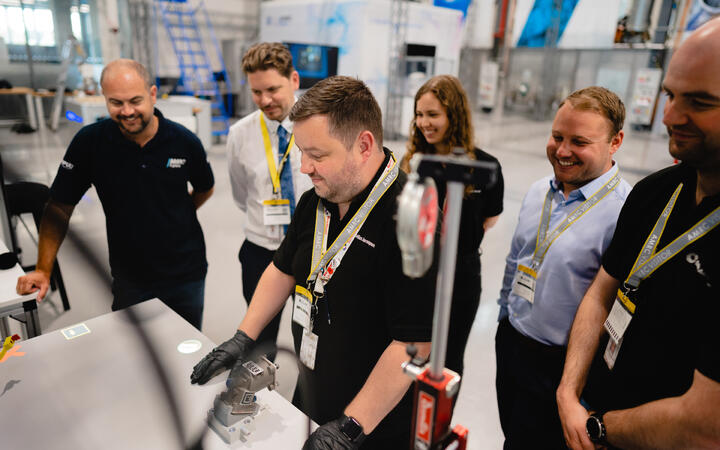Building smart production lines for aerospace
A new concept assembly process has been developed by AMRC Cymru for world leading aerospace manufacturer Collins Aerospace for their actuation systems site in Wolverhampton.
Background
The team at AMRC Cymru, part of the University of Sheffield Advanced Manufacturing Research Centre (AMRC), was tasked with developing a Smart Assembly and Inspection Demonstration (SAID) unit that could guide an aircraft operative to assemble a component from start to finish using different technologies and without the need for paper instructions.
The item chosen was a gearbox component that was previously assembled using conventional methods such as worded instructions and drawings.
Challenge
The challenge was to create a system that would guide an operator, with little or no experience, to correctly assemble the component whilst utilising the Smart Workstation technology.
The aim of the project was to transform the current process of the product assembly into a Smart Workstation and inspection system in just ten weeks and showcase this through a live demonstration at their Wolverhampton factory.
The complete workstation was required to save processing time, reduce the number of errors and make training a lot simpler. It needed to be inclusive for operators with varying levels of experience, for people who spoke different languages and for people with disabilities. The inspection element was to be incorporated into the build to ensure the sign off process met the set quality standard requirements and was required to utilise existing and emerging technology.
Innovation
The first step was to create work instructions for the user and identify the build steps and trigger points. Working in collaboration with Collins Aerospace, a series of instructions for the workstation were established. The team at AMRC Cymru then agreed on a variety of methods to demonstrate this including text display, graphics, video animations, CAD, 3D printing and torque tooling.
The next stage was the development of the interface, settings and trigger points. Each graphic and symbol was developed to be in the same position with the same function so that any issues could be logged and any problems could be identified and rectified whilst the build process was running.
A translator within the team was able to translate all English instructions to French, creating two separate work instruction areas in the LGS software, either of which could be selected at the beginning of the work instructions.
Using CAD systems, a cradle device was designed to make the assembly of the gearbox as easy and clear as possible. This allowed the instructions for assembly to be highlighted by the LGS projector on the physical parts of the assembly for quick and easy movement of the product when carrying out the assembly instructions.
The designs were printed using various 3D printers and fixed in a set position to ensure they remained consistent. Animation videos were created for more complex stages of the build to show the part being assembled in the correct orientation alongside a highlighted graphic for the operator to follow.
The DIOTA augmented reality system was used for the final inspection part using the Windows Surface Pro tablet. The CAD model was imprinted into the DIOTA computer applying views, conformity checks and additional comments which could aid the user during inspection, eliminate randomness and ensure it remained consistent.
Results
The result was a hi-tec Smart Workstation which could incorporate any language, enabling users of all experience and abilities to assemble the product via a simpler and paperless process.
Collins implemented a demonstration station at its Midlands site, the concept station was successfully trailed and has now led to the site purchasing their own equipment for further development.
- Efficiency: The technology allows the workstation to be tailored to user settings such as language selection for the display text. With further development Collins Aerospace expects to reduce training time for the trialled product. Once an operator is experienced, the Smart Workstation can have a more condensed set of instructions that captures only the key parts, while simple instructions (such as nut and bolt assembly) can be removed.
- Inclusivity: The workstation not only supports speakers of different languages, it also has the potential to remove a lot of other barriers, particularly for employees with a learning or physical disability. The workstation can be set at different heights so it can be operated by someone in a wheelchair, and set-up for people who are left or right-handed.
- Quality: Incorporating both images and animation reduced the amount of text required within the process which increased the chance of instructions being interpreted correctly and resulted in a reduction in paper systems. The data capture allows Collins to make further improvements, record critical points and streamline the whole process. Each step can be checked utilising the data analysis software where simple KPIs can be tracked to ensure that set targets are being achieved, such as TAKT time, quality standards and returns of parts.
- Technology: The Smart Workstation works with the user to support the build process. The integration of smart technology means that Collins Aerospace can transform their production system with Smart Workstations and improve their manufacturing processes. For instance, electric torque tooling can be incorporated into the workstation and linked to achieve the set torque requirements before the work instruction moves forward- ensuring quality conformities are tracked, met and more importantly, recorded within the assembly build.
Impact
The results of this project led Collins Aerospace to purchase the Smart Workstation equipment and they are now developing this technology further for current production lines and integration within their own systems.
The Smart Workstation has proven to be a powerful piece of equipment for Collins as it combines digital integration, an element of automation and skills of the team. It can be applied to other components and products as the principles and benefits are universal.



